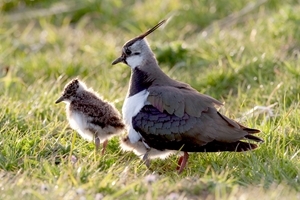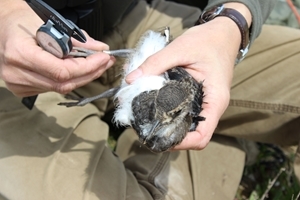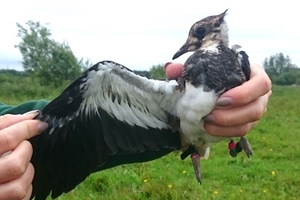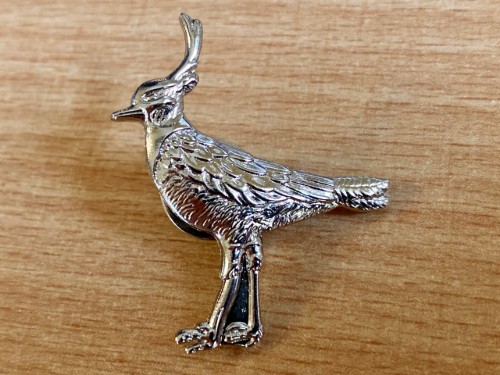Key points
- Breeding wader numbers have fallen across Europe in recent decades, in part because wetter landscapes have been drained. Wader chicks feed on invertebrates – for example insects, spiders and worms – which are more abundant and accessible in wetter landscapes.
- On many nature reserves and some farms, wet features have been installed to encourage breeding waders. This study looked at fields with wet features and compared them to areas or drier grazing marsh.
- Wet features supported more invertebrate food than dry areas. Lapwing chicks foraged more in wet areas, and the food items found there were larger.
- Chicks that hatched in the later part of the season, which typically have lower survival, grew better and had improved body condition in fields with wet features compared to grazing marsh.
- Installing wet features can help support breeding waders.
Background
 Many species of farmland bird have been declining in number in recent decades, in part as a result of changes to farming methods. For breeding waders, wetland drainage is one of the main drivers of these losses. Lapwing and other wader chicks forage for insect food in wet areas of grassland or fields, and most historically suitable agricultural land is now too dry to support breeding populations.
Many species of farmland bird have been declining in number in recent decades, in part as a result of changes to farming methods. For breeding waders, wetland drainage is one of the main drivers of these losses. Lapwing and other wader chicks forage for insect food in wet areas of grassland or fields, and most historically suitable agricultural land is now too dry to support breeding populations.
In nature reserves, and increasingly on farmland with support from agri-environment schemes, shallow wet features, in the form of foot drains or shallow scrapes, are being installed to try to support higher populations of key invertebrates, which wader chicks can feed on. Chick distribution is known to be associated with wet features on fields and grasslands, and this paper looks at the effect of installing such features on invertebrates and lapwing chicks.
What they did
 The scientists looked at nine sites within the Norfolk Broads. These were lowland wet grassland sites, five managed by conservation organisations and four managed by commercial landowners as farmland. All sites were grazed, to different intensities, and had some level of water control.
The scientists looked at nine sites within the Norfolk Broads. These were lowland wet grassland sites, five managed by conservation organisations and four managed by commercial landowners as farmland. All sites were grazed, to different intensities, and had some level of water control.
The study looked at the abundance of invertebrates at the sites, comparing wet and dry areas on the ground and in the air 10cm above ground level. It looked at chick foraging behaviour, in terms of time spent and number of foraging pecks in the different areas, as well as chick growth and condition through the breeding season. Chicks were weighed and tagged in the nest shortly after hatching, and weighed regularly through the spring, on average around once a week. The type and density of wet features within each field were analysed along with this data on chick food, feeding behaviour and growth.
What they found
More ground-dwelling and aerial invertebrates were found in areas with wet features compared to grazing marsh without these features.
Only very few or no lapwing chicks were seen foraging in dry features, and foraging rates were significantly higher in wet pools and footdrains compared to grazing marsh. There was also a difference in the dry weight of the individual items foraged from these different habitats, with the estimated biomass of each food item being higher in wet pools than wet footdrains, and both of these being higher than grazing marsh.
Chicks grew with age following a typical growth curve, which varied between the years. In 2007, chicks were in much poorer condition than in 2005 or 2006, because of usually high May and June rainfall. For chicks hatched earlier in the breeding season, the density of wet features in the field had little impact on growth, but for those hatched from the middle of May, chick condition was significantly improved in fields with higher density of wet features.
What does this mean?
 This study shows that chicks prefer to forage in wet features, that more food is available for them in these areas, and that the food items they find there are larger compared to the drier grazing marshes. This in turn means that towards the end of the season, when water is scarcer in the landscape, the wet features provide some of the few good foraging sites. Chicks feeding in fields with such features had improved growth, leading to better body condition, particularly for chicks hatched after the middle of May.
This study shows that chicks prefer to forage in wet features, that more food is available for them in these areas, and that the food items they find there are larger compared to the drier grazing marshes. This in turn means that towards the end of the season, when water is scarcer in the landscape, the wet features provide some of the few good foraging sites. Chicks feeding in fields with such features had improved growth, leading to better body condition, particularly for chicks hatched after the middle of May.
Providing sources of water throughout the breeding season can improve conditions for chick growth, and re-instating wet features in grasslands is important to improve wader breeding success. This may be especially important in the future, as patterns of rainfall seem to be changing towards warmer weather with occasional periods of heavy rainfall, both of which can adversely affect chick survival. Managed wet features can provide a buffer against these conditions and benefit lapwing chicks.
Read the original paper
Eglington, S. M., Bolton, M. , Smart, M. A., Sutherland, W. J., Watkinson, A. R. and Gill, J. A. (2010), Managing water levels on wet grasslands to improve foraging conditions for breeding northern lapwing Vanellus vanellus. Journal of Applied Ecology, 47: 451-458.

Get your GWCT Lapwing Badge for £9.99
£5 from the sale of each badge goes directly to our Wader Tracking Appeal
You can support our biggest tracking project yet and help curlew, lapwing and woodcock with our brand new lapwing pin badge. £5 from the sale of each badge goes toward this vital project. Badge measures approx 3cm x 3.5cm.
View Badge >
or
Buy Now - £9.99 >
100% Secure. All Credit & Debit cards, PayPal, Apple Pay and Google Pay accepted.
